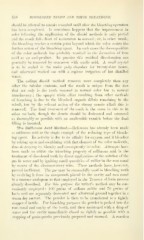Page 556 - My FlipBook
P. 556
554 DISCOLORED TEETH AND THEIR TREATMENT.
shoiikl be allowed to remain unsealed until after the bleaching operation
has been completed. It sometimes happens that the improvement in
color following the application of the dioxid methods is only partial
and the result falls short of restoration to normal ; or, in other words,
the bleaching reaches a certain point beyond which the color resists the
further action of the bleaching agent. In such cases the decomposition
of tlie color molecule has probably resulted in the formation of iron
oxid as an end-product. In practice this residual discoloration can
generally be removed by treatment with oxalic acid. A small crystal
is to be sealed in the moist pulp chamber for twenty-four liours,
and afterward washed out with a copious irrigation of hot distilled
water.
The sodium dioxid method removes more completely than any
other the tubular contents, and the result is unique from the fact
that not only is the tooth restored to normal color but to normal
translucency ; the opaque white effect resulting from other methods
of bleaching is due to the bleached organic debris remaining in the
tubuli, but by the solvent action of the strong caustic alkali this is
removed. The final treatment of the tooth is the same in this as in
other methods, though the dentin should be desiccated and saturated
as thoroughly as possible with an unalterable varnish before the final
filling is inserted.
The Sulfurous Acid Method.—Reference has already been made
to sulfurous acid as the single example of the reducing tyjje of bleach-
ing agent. Its activity is due to its affinity for oxygen, and it bleaches
by seizing upon and combining with that element of the color molecule,
thus destroying its identity and consequently its color. Attempts have
been made to utilize the bleaching property of sulfurous acid in the
treatment of discolored teeth by direct applications of the solution of the
gas in water and by igniting small quantities of sulfur in the root canal
by means of the electro-cautery wire. Those methods have, however,
proved inefficient. The gas may be successfully used in bleaching teeth
by evolving it from its compounds placed in the cavity and root canal
in a manner analogous to that employed in the Truman chlorin process
already described. For this purpose the writer's method may be con-
veniently employed : 100 grains of sodium sulfite and 70 grains of
boric acid are separately desiccated and afterward ground together in a
warm dry mortar. The powder is then to be transferred to a tightly
stoppered bottle. For bleaching purposes the powder is packed into the
root canal and cavity of the tooth, and then moistened with a drop of
water and the cavity immediately closed as tightly as possible with a
stopping of gutta-percha previously prepared and warmed. A reaction


